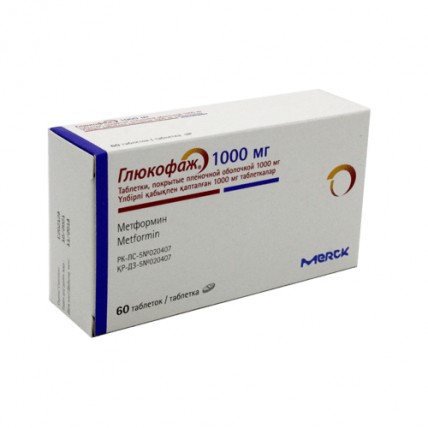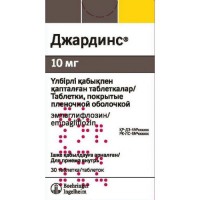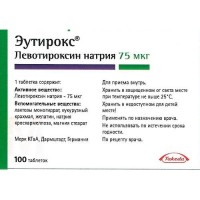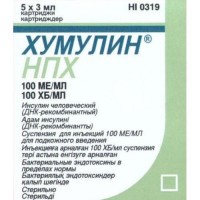Glucophage® (Metformin) 1000 mg (60 coated tablets)
- $21.70
Structure
One tablet contains 1000 mg metformin hydrochloride
Indications
- diabetes mellitus non-insulin dependent in adults with ineffective diet therapy (especially in obese patients)
- diabetes mellitus, accompanied by secondary insulin resistance, especially in severe obesity, in combination with insulin
- diabetes mellitus in children from 10 years of age - both with monotherapy and in combination with insulin
Mode of application
Adults: Monotherapy and combination therapy in combination with other oral antidiabetic agents:
The usual starting dose is one tablet 2-3 times daily after or during a meal.
After 10-15 days of treatment, the dose must be adjusted based on the results of blood glucose measurements. Slowly increasing the dose may help to improve gastrointestinal tolerance.
For patients who are prescribed high doses of the drug (2000-3000 mg per day), it is recommended to take Glucophage with a dosage of 1000 mg. The maximum recommended dose is 3000 mg per day (1 tablet of Glucophage 1000 mg in three divided doses).
If you are planning to switch from taking another antidiabetic drug: you must stop taking the other drug and start taking Glucophage at the dose indicated above.
Combination with insulin:
To achieve better blood glucose control, Glucophage and insulin can be used in combination therapy. The usual initial dose of Glucophage 500 mg or 850 mg is one tablet 2-3 times a day, Glucophage 1000 mg -1 tablet once a day, while the dose of insulin is selected based on the results of blood glucose measurements.
Children and adolescents:
In children from 10 years of age, Glucophage can be used both as monotherapy and in combination with insulin. The usual starting dose is 500 mg 2–3 times daily after or during a meal. After 10-15 days of treatment, the dose must be adjusted based on the results of blood glucose measurements. Slowly increasing the dose may improve gastrointestinal tolerance. The maximum recommended dose is 2000 mg of Glucophage per day, divided into 2-3 doses.
Elderly patients: due to a possible decrease in renal function in elderly people, the dose of Glucophage must be selected based on renal function (measurement of creatinine levels in the blood!).
Contraindications
- hypersensitivity to metformin hydrochloride or to any excipient
- diabetic ketoacidosis, diabetic precomatose state, coma
- renal failure or impaired renal function (creatinine clearance less than 60 ml / min in urine)
- dehydration, severe infection, hypoglycemic shock, intravenous administration of iodinated contrast agents, which can lead to impaired renal function
- cardiac or respiratory disorders with tissue hypoxia
- recent myocardial infarction
- alcoholism and acute alcohol intoxication
- anemia
- liver failure
- pregnancy, lactation period
- application for at least 2 days before and within 2 days after carrying out radioisotope or X-ray studies with the introduction of an iodine-containing contrast agent
Side effects
Very Often
- loss of appetite, nausea, vomiting, abdominal pain and diarrhea
Often
- taste disturbance
Very rarely
- skin reactions (itching, erythema, rash)
- lactic acidosis
- hepato-biliary disorders (transient increases in transaminases)
During pregnancy
When planning pregnancy, as well as in case of pregnancy while taking Glucophage, the drug should be canceled, and insulin therapy should be prescribed. You must inform your doctor about the onset of pregnancy while taking Glucophage. The mother and the newborn are monitored. Since there is no data on penetration into breast milk, this drug is contraindicated for breastfeeding. If necessary, the use of Glucophage during breastfeeding, breastfeeding should be discontinued
Interaction
Not recommended combinations
It is not recommended to take Danazol at the same time to avoid the hyperglycemic effect of the latter. If it is necessary to treat with danazol and after discontinuation of the latter, a dose adjustment of Glucophage is required under the control of glucose levels.
Alcohol intake increases the risk of developing lactic acidosis during acute alcohol intoxication, especially in cases of fasting or following a low-calorie diet, as well as with liver failure. While taking the drug, you should avoid taking alcohol and medicines containing alcohol.
Combinations requiring special care
Chlorpromazine: When taken in high doses (100 mg daily), it increases glycemia by decreasing insulin release. When treating with antipsychotics and after stopping the reception of the latter, a dose adjustment of Glucophage is required under the control of the glycemic level.
Systemic and local glucocorticosteroids reduce glucose tolerance, increase glycemia, sometimes causing ketosis. When treating with glucocorticosteroids and after discontinuation of the latter, a dose adjustment of Glucophage is required under the control of glycemic levels.
Diuretics: Concomitant use of loop diuretics can lead to the development of lactic acidosis due to possible functional renal failure. You should not prescribe Glucophage if creatinine clearance is below 60 ml / min.
Iodine-containing X-ray contrast agents: a radiological study using iodine-containing X-ray contrast agents can cause the development of lactic acidosis in patients with diabetes mellitus against the background of functional renal failure. The appointment of Glucophage should be canceled 48 hours before and not renewed earlier than 2 days after an X-ray examination using radiopaque contrast media.
Beta-2 sympathomimetics in the form of injections: increase glycemia due to stimulation of beta-2-adrenergic receptors. In this case, glycemic control is necessary. Insulin administration is recommended if necessary.
It should be taken into account that ACE inhibitors and other antihypertensive drugs can lower blood glucose levels. If necessary, the dose of Glucophage should be adjusted.
With the simultaneous use of Glucophage with sulfonylurea derivatives, insulin, acarbose, salicylates, the hypoglycemic effect may be enhanced.
Overdose
When using Glucophage at a dose of 85 g, the development of hypoglycemia was not observed. However, in this case, the development of lactic acidosis was observed.
Early symptoms of lactic acidosis: nausea, vomiting, diarrhea, fever, abdominal pain, muscle pain, in the future there may be increased breathing rate, dizziness, impaired consciousness and the development of coma.
Treatment: In case of signs of lactic acidosis, treatment with Glucophage should be stopped immediately, the patient should be urgently hospitalized and, having determined the concentration of lactate, the diagnosis should be clarified. The most effective measure for removing lactate and Glucophage from the body is hemodialysis. Symptomatic treatment is also carried out.
Shelf life - 5 years









